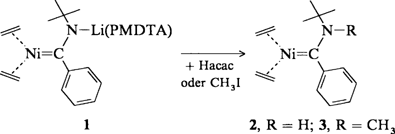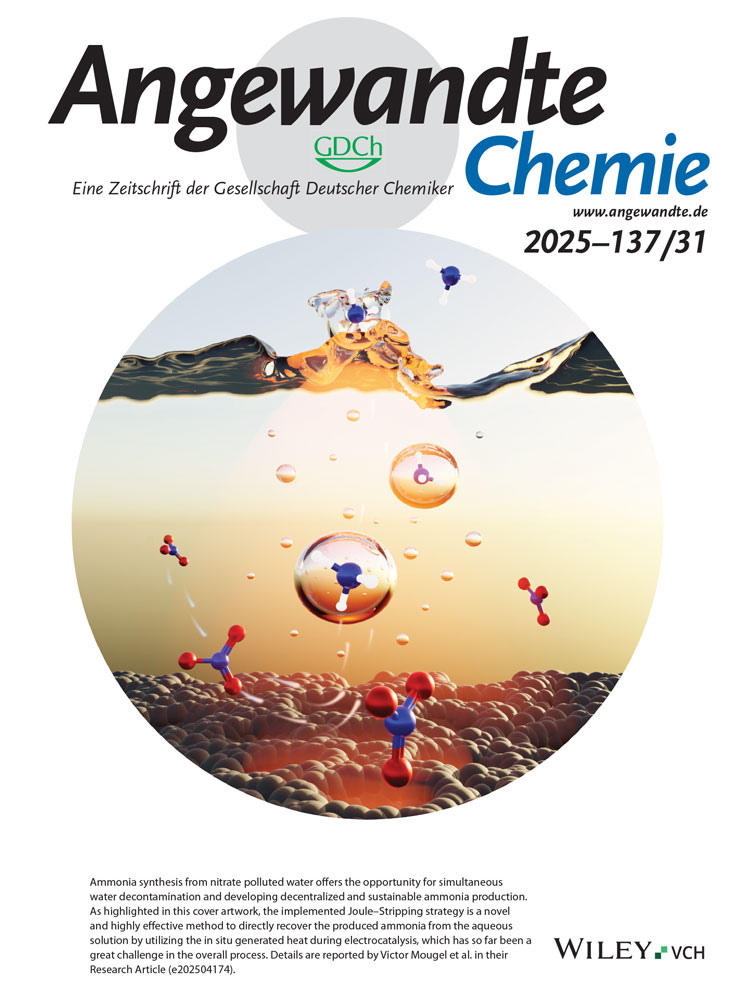Nickel(0)-Carbenkomplexe†
Barbara Gabor
Max-Planck-Institut für Kohlenforschung Kaiser-Wilhelm-Platz 1, W-4330 Mülheim a. d. Ruhr
Search for more papers by this authorProf. Dr. Carl Krüger
Max-Planck-Institut für Kohlenforschung Kaiser-Wilhelm-Platz 1, W-4330 Mülheim a. d. Ruhr
Search for more papers by this authorDr. Bernd Marczinke
Max-Planck-Institut für Kohlenforschung Kaiser-Wilhelm-Platz 1, W-4330 Mülheim a. d. Ruhr
Search for more papers by this authorDr. Richard Mynott
Max-Planck-Institut für Kohlenforschung Kaiser-Wilhelm-Platz 1, W-4330 Mülheim a. d. Ruhr
Search for more papers by this authorCorresponding Author
Prof. Dr. Günther Wilke
Max-Planck-Institut für Kohlenforschung Kaiser-Wilhelm-Platz 1, W-4330 Mülheim a. d. Ruhr
Max-Planck-Institut für Kohlenforschung Kaiser-Wilhelm-Platz 1, W-4330 Mülheim a. d. RuhrSearch for more papers by this authorBarbara Gabor
Max-Planck-Institut für Kohlenforschung Kaiser-Wilhelm-Platz 1, W-4330 Mülheim a. d. Ruhr
Search for more papers by this authorProf. Dr. Carl Krüger
Max-Planck-Institut für Kohlenforschung Kaiser-Wilhelm-Platz 1, W-4330 Mülheim a. d. Ruhr
Search for more papers by this authorDr. Bernd Marczinke
Max-Planck-Institut für Kohlenforschung Kaiser-Wilhelm-Platz 1, W-4330 Mülheim a. d. Ruhr
Search for more papers by this authorDr. Richard Mynott
Max-Planck-Institut für Kohlenforschung Kaiser-Wilhelm-Platz 1, W-4330 Mülheim a. d. Ruhr
Search for more papers by this authorCorresponding Author
Prof. Dr. Günther Wilke
Max-Planck-Institut für Kohlenforschung Kaiser-Wilhelm-Platz 1, W-4330 Mülheim a. d. Ruhr
Max-Planck-Institut für Kohlenforschung Kaiser-Wilhelm-Platz 1, W-4330 Mülheim a. d. RuhrSearch for more papers by this authorProfessor Horst Prinzbach zum 60. Geburtstag gewidmet
Abstract
Ein Tetracarbennickel(0)-Komplex konnte noch nicht synthetisiert werden, doch ergaben Studien zu diesem Thema andere interessante Resultate. So entstehen die 16e-Nickel(0)-Carbenkomplexe 2 und 3 bei der Protonierung bzw. Methylierung des aus Tris(ethen)nickel(0) und dem Additionsprodukt von Phenyllithium an tert-Butylisocyanid gewonnenen Komplexes 1 (PMDTA = Pentamethyldiethylentriamin).
References
- 1
U. Schöllkopf,
F. Gerhart,
Angew. Chem.
80
(1968)
842;
10.1002/ange.19680802006 Google ScholarAngew. Chem. Int. Ed. Engl. 7 (1968) 805.
- 2 A. Mollbach, G. Wilke, unveröffentlicht.
- 3 E. Bessler, B. M. Barbosa, W. Miller, J. Weidlein, Z. Naturforsch. B46 (1991) 490.
- 4 K. R. Pörschke, unveröffentlicht.
- 5 W. Kaschube, Dissertation, Universität Bochum 1987.
- 6 K. R. Pörschke, G. Wilke, Chem. Ber. 117 (1984) 56.
- 7 G. E. Niznik, W. H. Morrison III, H. M. Walborsky, J. Org. Chem. 39 (1974) 600.
- 8 Für alle neuen Verbindungen liegen korrekte Elementaranalysen vor. Arbeitsvorschrift für 11: Zu einer Lösung von 2.57 g (30.6 mmol) LiC6H5 in 100 mL Ether werden bei - 25°C 3.3 mL (29.2 mmol) tBuNC und 9.0 mL PMDTA gegeben. Aus der tiefroten Lösung fällt innerhalb 20 min ein orangefarbener Niederschlag aus, der bei Zugabe einer aus 6.43 g (29.1 mmol) [Ni(cdt)] in 50 mL Ether hergestellten Lösung von [Ni(C2H4)3] in Lösung geht. Nach 12 h bei - 78°C erhält man ein gelbes Kristallisat, das kalt abgesaugt, mit kaltem Ether gewaschen und bei - 30°C im Hochvakuum getrocknet wird. Ausb.: 8.2 g (62%). 1H-NMR (200 MHz, [D8]THF, - 30°C): δ = 1.27 (s, 9H; C(CH3)3), 1.93–2.09 (m, 8H; C2H4), 2.12 (s, 12H; N(CH3)2), 2.20 (s, 3H; NCH3), 2.30–2.40 (m, 8H; NCH2CH2N), 6.96–7.13, 5H; C6H5). 13C-NMR (75.5 MHz, [D8]THF, - 30°C): δ = 260.0 (NiC), 155.3, 123.8, 128.1, 124.3 (C6H5), 58.5, 56.3 (NCH2CH2N), 57.8 ( C(CH3)3), 46.2 (N(CH3)2), 43.4 (C2H4), 32.1 C( C H3)3), 44.2 (NCH3).
- 9 E. O. Fischer, F. R. Kreißl, E. Winkler, C. G. Kreiter, Chem. Ber. 105 (1972) 588.
- 10 Arbeitsvorschrift für 13: 1.28 g (2.82 mmol) 11 in 20 mL THF werden bei - 30°C mit 0.75 mL (2.86 mmol) 4,7,13,18-Tetraoxa-1,10-diazabicyclo-[8.5.5]eicosan (Kryptofix 211) und 395 mg (2.8 mmol) CH3I in 10 mL Ether umgesetzt. Es fällt ein gelber Niederschlag aus. Man erwärmt innerhalb 1 h auf 0°C und zieht den Ether im Hochvakuum ab. Man nimmt den Rückstand in Pentan auf, filtriert und erhält aus der roten Lösung bei - 78°C orangefarbene Prismen, die abfiltriert, mit Pentan gewaschen und im Hochvakuum bei 0°C getrocknet werden. 558 mg (68°). 1H-NMR (400 MHz, [D8]THF, - 30°C): δ = 1.52 (s, 9H; C(CH3)3), 2.18, 2.39 (m, 8H; C2H4), 2.99 (s, 3H; NCH3), 6.67–7.16 (m, 5H; C6H5). 13C-NMR (75.5 MHz, [D8]THF, - 30°C): δ = 280.4 (NiC), 148.1, 120.5, 128.7, 124.6 (C6H5), 63.9 ( C(CH3)3), 48.6 (C2H4), 38.4 (NCH3), 29.4 (C( CH3)3). Massenspektrum (70 eV/50°C): m/z 289 ( M⊕) (ber. 289 für 58Ni).
- 11 Arbeitsvorschrift für 14: Zu einer Suspension von 9.13 g (20.1 mmol) 11 in 80 mL Ether gibt man bei - 40°C eine Lösung von 2.1 mL (20.4 mmol) Acetylaceton in 20 mL Ether und erwärmt auf 0°C. Nach 30 min wird ausgeschiedenes Lithiumacetylacetonat abfiltriert und die rote Lösung auf - 78°C gekühlt. Die sich ausscheidenden orangefarbenen Kristalle werden abgetrennt, mit Pentan gewaschen und bei - 20°C im Hochvakuum getrocknet. 14 kristallisiert zunächst zusammen mit einem halben Äquivalent PMDTA, das durch Umkristallisieren aus Pentan entfernt wird. 3.44 g (62%). 1H-NMR (400 MHz, [D8]THF, - 30°C): δ = 1.40 (s, 9H; C(CH3)3), 2.21–2.35 (m, 8H; C2H4), 7.0–7.18 (m, 5H; C6H5), 9.27 (s, 1H; NH). 13C-NMR (75.5 MHz, [D8]THF, 40°C): δ = 277.3 (NiC), 150.4, 123.4, 128.5, 127.4 (C6H5), 57.4 ( C(CH3)3), 48.3 (C2H4), 30.1 (C( CH3)3. Massenspektrum (70 eV/40°C): m/z 275 ( M⊕) (ber. 275 für 58Ni).
- 12 B. E. Mann, B. F. Taylor: 13C-NMR-Data for Organometallic Compounds, Academic Press, London 1981.
- 13 Kristallstrukturanalyse von 13 (Formel C16H25NNi, Mr = 290.1): Kristallgröße 0.20 × 0.20 × 0.42 mm, a = 10.002(2), b = 11.949(2), c = 12.925(3) Å, β = 100.24(2)°, V = 1520.1 Å3. T = - 173°C, ϱber = 1.27 gcm−3, μ = 12.66 cm−1, F(000) = 624 e, Z = 4, Kristallsystem monoklin, Raumgruppe P21/ a (Nr. 14), Enraf-Nonius-CAD4-Diffraktometer, γ = 0.71069 Å, Meßmethode ω-2 θ, 19133 gemessene Reflexe (± h, + k, + l) [EDD-Bestimmung, X-X], [sinθ/γ]max 0.90 Å−1, analytische Absorptionskorrektur (min: 1.253, max: 1.418), 9214 unabhängige und 7121 beobachtete Reflexe [ I > 2 s̀(I)], 263 verfeinerte Parameter; Schweratom-Methode, H-Atom-Positionen gefunden und in die Least-squares-Verfeinerung aufgenommen, R = 0.039, Rw = 0.035 [ w = 1/s̀2 (F0)], maximale Restelektronendichte 0.91 eÅ−3. Siehe auch [16].
- 14 Arbeitsvorschrift für 23: Zu einer Lösung von 861.5 mg (3.12 mmol) 14 in 25 mL Toluol gibt man bei - 78°C unter Rühren eine Lösung von 0.95 mL (3.1 mmol) dippe in 5 mL Toluol und erwärmt 2 h auf - 10°C. Man engt die Lösung im Hochvakuum stark ein und versetzt mit 20 mL Pentan. Innerhalb eines Tages scheiden sich bei - 78°C Kristalle aus, die abgetrennt, mit Pentan gewaschen und bei Raumtemperatur im Ölpumpenvakuum getrocknet werden. Ausb.: 927 mg (62%). FP = 160°C (Zers.). 1H-NMR (400 MHz, [D8]THF, 27°C): δ = 0.08–1.35 (m, 24H; P(CH(C H3)2), 1.25 (s, 9H; C(CH3)3), 1.63–2.28 (m, 4H; P(C H(CH3)2), 5.05 (d, 1H; CH = NC(CH3)3, 6.75–7.27 (m, 5H; C6H5). 13C-NMR (75.5 MHz), [D8]THF, - 30°C): δ = 150.4, 124.9, 128.1, 121.9 (C6H5), 67.7 ( C H = NC(CH3)3), 56.1 ( C(CH3)3), 33.4 (C(C H3) 26.9, 26.5, 25.1, 23.2 (P C(CH3)2), 21.1, 21.0, 20.4, 20.0, 19.7, 18.8, 17.4, 16.7 (PC(C H3)2), 20.7, 20.1 (PCH2CH2P). 31P-NMR (32.4 MHz, [D8]Toluol, 38°C): δ = 63.6, 65.8 (d; JPP = 66.0 Hz). Massenspektrum (70 eV/120°C): m/z 481 ( M⊕) (ber. 481 für 58Ni).
- 15 Kristallstrukturanalyse von 23 (C25H47NiNP2, Mr = 482.3): Kristallgröße 0.14 × 0.29 × 0.36 mm, a = 16.943(2), b = 17.420(2), c = 9.434(2) Å, β = 94.39(1)°, V = 2776.2 Å3, ϱber = 1.15 gcm−3, μ = 8.25 cm−1, F(000) = 1048 e, Z = 4, Kristallsystem monoklin, Raumgruppe Cc (Nr. 9), Enraf-Nonius-CAD4-Diffraktometer, γ = 0.71069 Å, Meßmethode ω-2 θ, 6267 gemessene Reflexe (± h, ± k, + l), [(sinθ/γ]max 0.65 Å−1, 3140 unabhängige und 2509 beobachtete Reflexe [ I > 2 s̀( I)], 261 verfeinerte Parameter; Schweratom-Methode, H-Atom-Positionen berechnet und in die Least-squares-Verfeinerung nicht aufgenommen, R = 0.031, Rw = 0.033 [ w = 1/s̀2 ( F0)], maximale Restelektronendichte 0.40 eÅ−3. Siehe auch [16].
- 16 Weitere Einzelheiten zu den Kristallstrukturanalysen können beim Fachinformationszentrum Karlsruhe, Gesellschaft für wissenschaftlich-technische Information mbH, W-7514 Eggenstein-Leopoldshafen 2, unter Angabe der Hinterlegungsnummer CSD-55642, der Autoren und des Zeitschriftenzitats angefordert werden.
Citing Literature
This is the
German version
of Angewandte Chemie.
Note for articles published since 1962:
Do not cite this version alone.
Take me to the International Edition version with citable page numbers, DOI, and citation export.
We apologize for the inconvenience.





